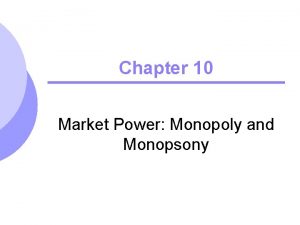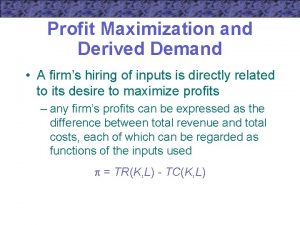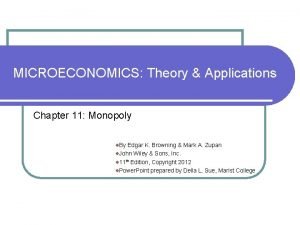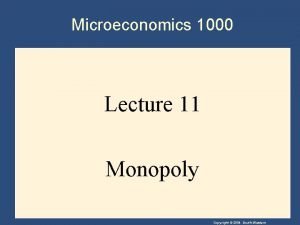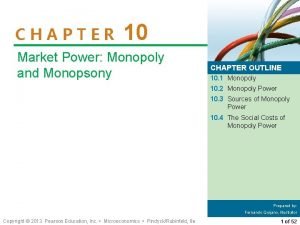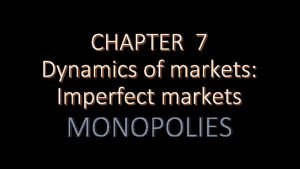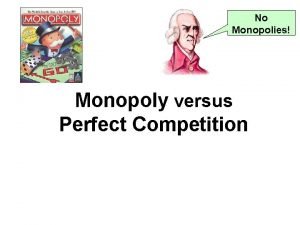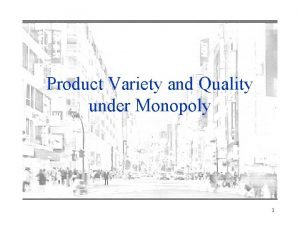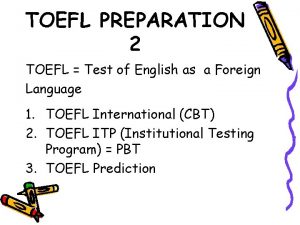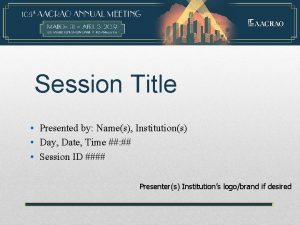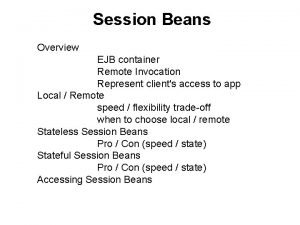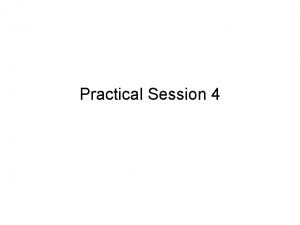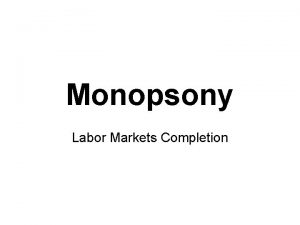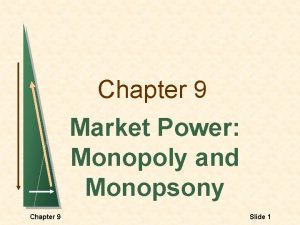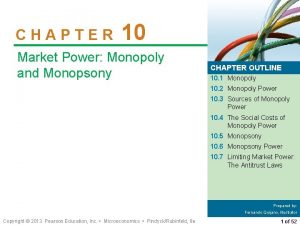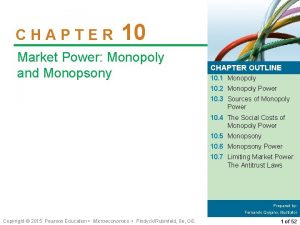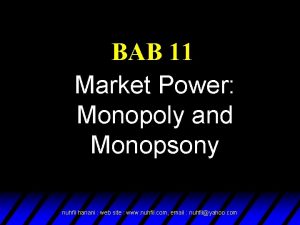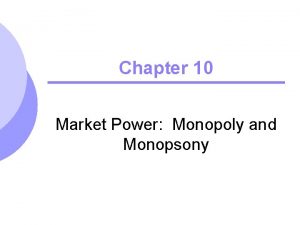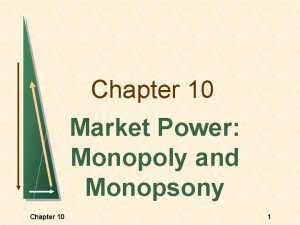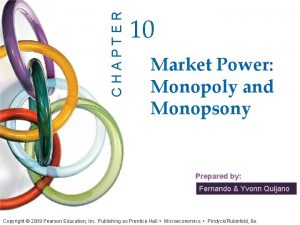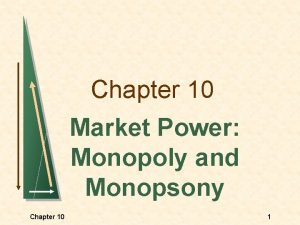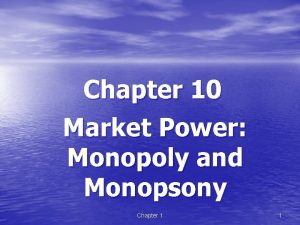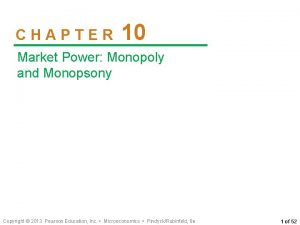Session 12 Monopoly Power and Monopsony Monopoly Power





































- Slides: 37

Session 12: Monopoly Power and Monopsony Monopoly Power • Pure monopoly is rare • However, a market with several firms, each facing a downward sloping demand curve, will produce so that price exceeds marginal cost • Firms often product similar goods that have some differences, thereby differentiating themselves from other firms

Session 12: Monopoly Power and Monopsony Monopoly Power: Example • Four firms share a market for 20, 000 toothbrushes at a price of $1. 50 • Profits maximizing quantity for each firm is where MR – MC • In our example that is 5000 units for Firm A, with a price of $1. 50, which is greater than marginal cost • Although Firm A is not a pure monopolist, they have monopoly power

Session 12: Monopoly Power and Monopsony The Demand for Toothbrushes $/Q 2. 00 At a market price of $1. 50, elasticity of demand is -1. 5. $/Q 2. 00 Firm A has some monopoly power and charges a price which exceeds MC where MR=MC. 1. 60 1. 50 MCA 1. 50 1. 40 DA Market Demand 1. 00 MRA 1. 00 10, 000 20, 000 30, 000 Quantity 3, 000 5, 000 7, 000 QA

Session 12: Monopoly Power and Monopsony Measuring Monopoly Power • Our firm would have more monopoly power, of course, if it could get rid of the other firms – But the firm’s monopoly power might still be substantial • How can we measure monopoly power to compare firms? • What are the sources of monopoly power? – Why do some firms have more than others?

Session 12: Monopoly Power and Monopsony Measuring Monopoly Power • Could measure monopoly power by the extent to which price is greater than MC for each firm • Lerner’s Index of Monopoly Power – L = (P - MC)/P • The larger the value of L (between 0 and 1) the greater the monopoly power – L is expressed in terms of Ed • L = (P - MC)/P = -1/Ed • Ed is elasticity of demand for a firm, not the market

Session 12: Monopoly Power and Monopsony Monopoly Power • Monopoly power, however, does not guarantee profits • Profit depends on average cost relative to price • One firm may have more monopoly power but lower profits due to high average costs

Session 12: Monopoly Power and Monopsony Number of Firms • The monopoly power of a firm falls as the number of firms increases; all else equal – More important are the number of firms with significant market share – Market is highly concentrated if only a few firms account for most of the sales • Firms would like to create barriers to entry to keep new firms out of market – Patent, copyrights, licenses, economies of scale

Session 12: Monopoly Power and Monopsony Interaction Among Firms • If firms are aggressive in gaining market share by, for example, undercutting the other firms, prices may reach close to competitive levels • If firms collude (violation of antitrust rules), could generate substantial monopoly power • Markets are dynamic and therefore, so is the concept of monopoly power

Session 12: Monopoly Power and Monopsony The Social Costs of Monopoly Power • Monopoly power results in higher prices and lower quantities • However, does monopoly power make consumers and producers in the aggregate better or worse off? • We can compare producer and consumer surplus when in a competitive market and in a monopolistic market

Session 12: Monopoly Power and Monopsony The Social Costs of Monopoly • Perfectly competitive firm will produce where MC = D �PC and QC • Monopoly produces where MR = MC, getting their price from the demand curve � PM and QM • There is a loss in consumer surplus when going from perfect competition to monopoly • A deadweight loss is also created with monopoly

Session 12: Monopoly Power and Monopsony Deadweight Loss from Monopoly Power $/Q Lost Consumer Surplus Pm Deadweight Loss A B C PC MC AR=D MR Qm QC Quantity Because of the higher price, consumers lose A+B and producer gains A -C.

Session 12: Monopoly Power and Monopsony The Social Costs of Monopoly • Social cost of monopoly is likely to exceed the deadweight loss • Rent Seeking – Firms may spend to gain monopoly power • Lobbying • Advertising • Building excess capacity

Session 12: Monopoly Power and Monopsony • A monopsony is a market in which there is a single buyer • An oligopsony is a market with only a few buyers • Monopsony power is the ability of the buyer to affect the price of the good and pay less than the price that would exist in a competitive market

Session 12: Monopoly Power and Monopsony • Typically choose to buy until the benefit from last unit equals that unit’s cost • Marginal value is the additional benefit derived from purchasing one more unit of a good – Demand curve – downward sloping • Marginal expenditure is the additional cost of buying one more unit of a good – Depends on buying power

Session 12: Monopoly Power and Monopsony • Competitive Buyer – Price taker – P = Marginal expenditure = Average expenditure – D = Marginal value • Graphically can compare competitive buyer to competitive seller

Session 12: Monopoly Power and Monopsony Competitive Buyer Compared to Competitive Seller $/Q Buyer $/Q Seller ME = AE P* AR = MR P* ME = MV at Q* ME = P* P* = MV MR = MC P* = MR P* = MC D = MV Q* Quantity MC Q* Quantity

Session 12: Monopoly Power and Monopsony Monopsonist Buyer • Buyer will buy until value from last unit equals expenditure on that unit • The market supply curve is not the marginal expenditure curve – Market supply shows how much must pay per unit as a function of total units purchased – Supply curve is average expenditure curve – Upward sloping supply implies the marginal expenditure curve must lie above it – Decision to buy extra unit raises price paid for all units

Session 12: Monopoly Power and Monopsony Monopsonist Buyer Monopsony • ME above S • Quantity where ME = MV: Qm • Price from Supply curve: Pm $/Q ME S = AE Competitive • P = P C • Q = Q C PC P*m D= MV Q*m QC Quantity

Session 12: Monopoly Power and Monopsony Monopoly and Monopsony • Monopsony is easier to understand if we compare to monopoly • We can see this graphically • Monopolist – Can charge price above MC because faces downward sloping demand (average revenue) – MR < AR – MR = MC gives quantity less than competitive market and price that is higher

Session 12: Monopoly Power and Monopsony Monopoly and Monopsony $/Q Monopoly Note: MR = MC; AR > MR; P > MC MC P* PC AR MR Q* QC Quantity

Session 12: Monopoly Power and Monopsony Monopoly and Monopsony $/Q Monopsony Note: ME = MV; ME > AE; MV > P M E S = AE PC P* MV Q * Q C Quantity

Session 12: Monopoly Power and Monopsony Monopoly and Monopsony • Monopoly – – MR < P P > MC Qm < QC Pm > PC • Monopsony – – ME > P P < MV Qm < QC Pm < PC

Session 12: Monopoly Power and Monopsony Power • The degree of monopsony power depends on three factors: – Number of buyers • The fewer the number of buyers, the less elastic the supply and the greater the monopsony power – Interaction Among Buyers • The less the buyers compete, the greater the monopsony power

Session 12: Monopoly Power and Monopsony Power • The degree of monopsony power depends on three factors (cont’d): – Elasticity of market supply • Extent to which price is marked down below MV depends on elasticity of supply facing buyer • If supply is very elastic, markdown will be small • The more inelastic the supply, the more monopsony power

Session 12: Monopoly Power and Monopsony Power: Elastic Versus Inelastic Supply Elastic $/Q MV - P* Inelastic ME MV - P* ME S = AE P* MV Q* Quantity

Session 12: Monopoly Power and Monopsony Social Costs of Monopsony Power • Since monopsony power gives lower prices and lower quantities purchased, we would expect sellers to be worse off and buyers better off • We can show the effects of monopsony power using producer and consumer surplus compared to competitive market – For sole monopsonist, quantity is where ME = MV and price is from demand – For competitive market, quantity and price where S=D

Session 12: Monopoly Power and Monopsony Deadweight Loss from Monopsony Power $/Q ME Deadweight Loss Consumers gain A-B PC S = AE B A C P* MV Lost Producer Surplus Q* QC Quantity

Session 12: Monopoly Power and Monopsony Power • Bilateral Monopoly – Market where there is only one buyer and one seller – Bilateral monopoly is rare, however, markets with a small number of sellers with monopoly power selling to a market with few buyers with monopsony power is more common – Even with bargaining, in general, monopsony and monopoly power will counteract each other

Session 12: Monopoly Power and Monopsony Limiting Market Power: The Antitrust Laws • Market power harms some players in the market – buyer or seller • Market power reduces output, leading to deadweight loss • Excessive market power could raise problems of equity and fairness

Session 12: Monopoly Power and Monopsony Limiting Market Power: The Antitrust Laws • What can we do to limit market power and keep it from being used anticompetitively? – Tax away monopoly profits and redistribute to consumers • Difficult to measure and find all those who lost – Direct price regulation of natural monopolies – Keep firms from acquiring excessive market power • Antitrust laws

Session 12: Monopoly Power and Monopsony Limiting Market Power: The Antitrust Laws • Rules and regulations designed to promote a competitive economy by: – Prohibiting actions that restrain or are likely to restrain competition – Restricting the forms of allowable market structures • Monopoly power arises in a number of ways, each of which is covered by the antitrust laws

Session 12: Monopoly Power and Monopsony Limiting Market Power: The Antitrust Laws • Sherman Act (1890) – Section 1 – Prohibits contracts, combinations, or conspiracies in restraint of trade • Explicit agreement to restrict output or fix prices • Implicit collusion through parallel conduct – Form of implicit collusion in which one firm consistently follows actions of another – Example • In 1999, four of the world’s largest drug and chemical companies were found guilty of fixing prices of vitamins sold in US

Session 12: Monopoly Power and Monopsony Limiting Market Power: The Antitrust Laws • Sherman Act (1890) – Section 2 – Makes it illegal to monopolize or attempt to monopolize a market and prohibits conspiracies that result in monopolization • Clayton Act (1914) – Makes it unlawful to require a buyer or lessor not to buy from a competitor

Session 12: Monopoly Power and Monopsony Limiting Market Power: The Antitrust Laws • Clayton Act (1914) – Prohibits predatory pricing • The practice of pricing to drive current competitors out of business and to discourage new entrants in a market so that a firm can enjoy higher future profits – Prohibits mergers and acquisitions if they “substantially lessen competition” or “tend to create a monopoly”

Session 12: Monopoly Power and Monopsony Limiting Market Power: The Antitrust Laws • Robinson-Patman Act (1936) – Amendment to the Clayton Act – Prohibits price discrimination if it causes buyers to suffer economic damages and competition is reduced

Session 12: Monopoly Power and Monopsony Limiting Market Power: The Antitrust Laws • Federal Trade Commission Act (1914, amended 1938, 1973, 1975) – Created the Federal Trade Commission (FTC) – Supplements the Sherman and Clayton Acts by fostering competition through a set of prohibitions against unfair and anticompetitive practices • Prohibitions against deceptive advertising, labelling, agreements with retailer to exclude competing brands

Session 12: Monopoly Power and Monopsony References: § Chapter 9 Microeconomics, R. S. Pyndick, D. L. Rubinfeld and Prem L. Mehta, Peason Publishing House. • Monopoly and akdeniz. bilkent. edu. tr/courses/micro/Ch 10_Pindyck. ppt Monopsony:
 Monopsony power diagram
Monopsony power diagram Monopsony profit maximization
Monopsony profit maximization Monopsony with trade union diagram
Monopsony with trade union diagram Daily 10/4 keller williams
Daily 10/4 keller williams Lerner index of monopoly power
Lerner index of monopoly power Lerner index
Lerner index Advantages of monopoly
Advantages of monopoly Social cost of monopoly
Social cost of monopoly Triangle of power
Triangle of power Monopolistic competition pictures
Monopolistic competition pictures Monopoly advantages
Monopoly advantages Pure competition advertising
Pure competition advertising Difference between monopoly and monopolistic competition
Difference between monopoly and monopolistic competition Difference between monopoly and perfect competition
Difference between monopoly and perfect competition Difference between perfect competition and monopoly
Difference between perfect competition and monopoly Product variety and quality under monopoly
Product variety and quality under monopoly Super normal profit meaning
Super normal profit meaning P=mc
P=mc Difference between perfect competition and monopoly
Difference between perfect competition and monopoly Product variety and quality under monopoly
Product variety and quality under monopoly Deadweight loss in monopoly
Deadweight loss in monopoly Pure competition and monopoly _____
Pure competition and monopoly _____ Solar power satellites and microwave power transmission
Solar power satellites and microwave power transmission Potential power
Potential power Dispersive power of a grating is defined as
Dispersive power of a grating is defined as Windows 7 compatibility center
Windows 7 compatibility center Welcome to the new session
Welcome to the new session Session
Session Skill 23: anticipate the topics answers
Skill 23: anticipate the topics answers Team norming session
Team norming session 6 session name
6 session name Session title examples
Session title examples Asp.net session management
Asp.net session management Stateful session bean life cycle
Stateful session bean life cycle Multi product profit volume chart
Multi product profit volume chart To the principal
To the principal Ergonomicsl
Ergonomicsl Factor label definition
Factor label definition
